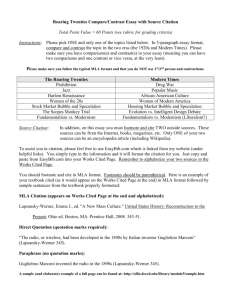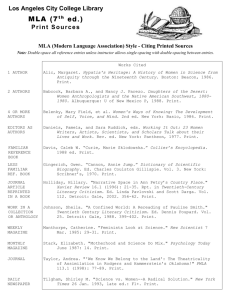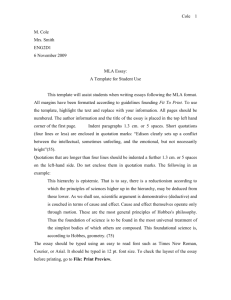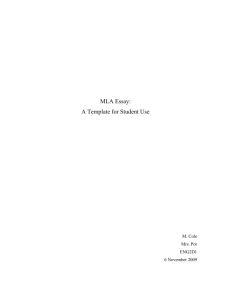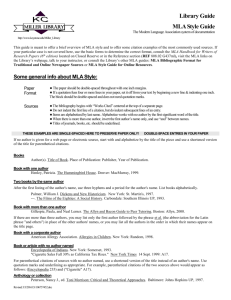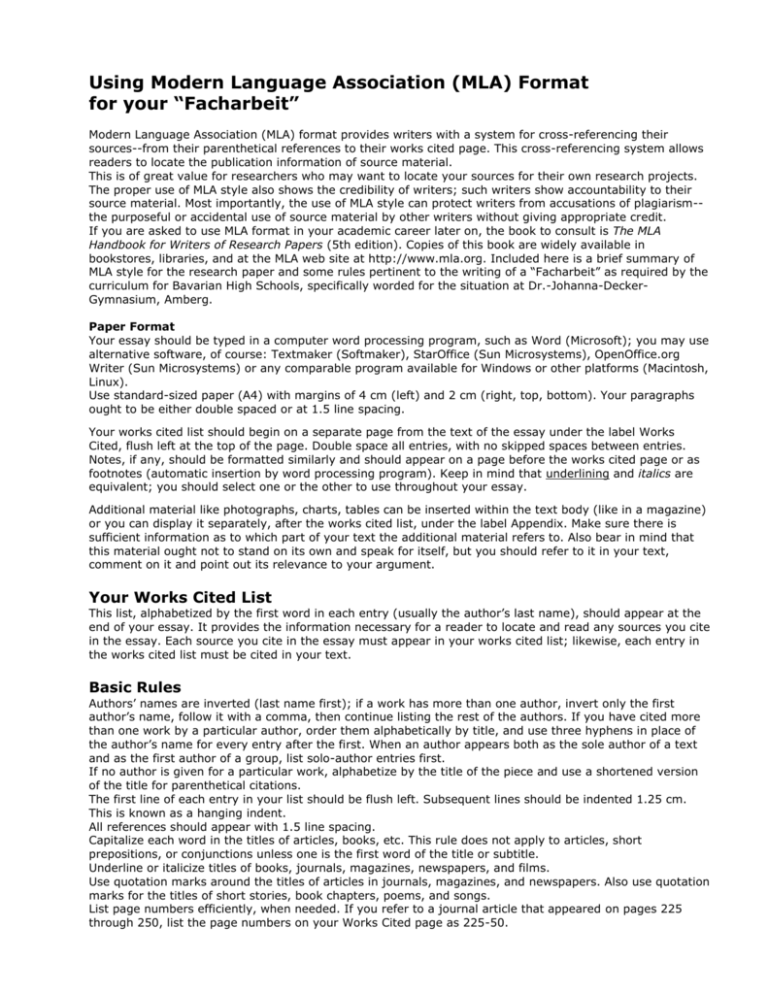
Using Modern Language Association (MLA) Format
for your “Facharbeit”
Modern Language Association (MLA) format provides writers with a system for cross-referencing their
sources--from their parenthetical references to their works cited page. This cross-referencing system allows
readers to locate the publication information of source material.
This is of great value for researchers who may want to locate your sources for their own research projects.
The proper use of MLA style also shows the credibility of writers; such writers show accountability to their
source material. Most importantly, the use of MLA style can protect writers from accusations of plagiarism-the purposeful or accidental use of source material by other writers without giving appropriate credit.
If you are asked to use MLA format in your academic career later on, the book to consult is The MLA
Handbook for Writers of Research Papers (5th edition). Copies of this book are widely available in
bookstores, libraries, and at the MLA web site at http://www.mla.org. Included here is a brief summary of
MLA style for the research paper and some rules pertinent to the writing of a “Facharbeit” as required by the
curriculum for Bavarian High Schools, specifically worded for the situation at Dr.-Johanna-DeckerGymnasium, Amberg.
Paper Format
Your essay should be typed in a computer word processing program, such as Word (Microsoft); you may use
alternative software, of course: Textmaker (Softmaker), StarOffice (Sun Microsystems), OpenOffice.org
Writer (Sun Microsystems) or any comparable program available for Windows or other platforms (Macintosh,
Linux).
Use standard-sized paper (A4) with margins of 4 cm (left) and 2 cm (right, top, bottom). Your paragraphs
ought to be either double spaced or at 1.5 line spacing.
Your works cited list should begin on a separate page from the text of the essay under the label Works
Cited, flush left at the top of the page. Double space all entries, with no skipped spaces between entries.
Notes, if any, should be formatted similarly and should appear on a page before the works cited page or as
footnotes (automatic insertion by word processing program). Keep in mind that underlining and italics are
equivalent; you should select one or the other to use throughout your essay.
Additional material like photographs, charts, tables can be inserted within the text body (like in a magazine)
or you can display it separately, after the works cited list, under the label Appendix. Make sure there is
sufficient information as to which part of your text the additional material refers to. Also bear in mind that
this material ought not to stand on its own and speak for itself, but you should refer to it in your text,
comment on it and point out its relevance to your argument.
Your Works Cited List
This list, alphabetized by the first word in each entry (usually the author’s last name), should appear at the
end of your essay. It provides the information necessary for a reader to locate and read any sources you cite
in the essay. Each source you cite in the essay must appear in your works cited list; likewise, each entry in
the works cited list must be cited in your text.
Basic Rules
Authors’ names are inverted (last name first); if a work has more than one author, invert only the first
author’s name, follow it with a comma, then continue listing the rest of the authors. If you have cited more
than one work by a particular author, order them alphabetically by title, and use three hyphens in place of
the author’s name for every entry after the first. When an author appears both as the sole author of a text
and as the first author of a group, list solo-author entries first.
If no author is given for a particular work, alphabetize by the title of the piece and use a shortened version
of the title for parenthetical citations.
The first line of each entry in your list should be flush left. Subsequent lines should be indented 1.25 cm.
This is known as a hanging indent.
All references should appear with 1.5 line spacing.
Capitalize each word in the titles of articles, books, etc. This rule does not apply to articles, short
prepositions, or conjunctions unless one is the first word of the title or subtitle.
Underline or italicize titles of books, journals, magazines, newspapers, and films.
Use quotation marks around the titles of articles in journals, magazines, and newspapers. Also use quotation
marks for the titles of short stories, book chapters, poems, and songs.
List page numbers efficiently, when needed. If you refer to a journal article that appeared on pages 225
through 250, list the page numbers on your Works Cited page as 225-50.
Basic Forms for Sources in Print
The MLA Handbook for Writers of Research Papers provides extensive examples covering a wide variety of
potential sources. If your particular case is not covered here, use the basic forms to determine the correct
format, consult the MLA Handbook. – As a pupil of my course, mail me at <elk@ringeisen.de>.
A book
Author(s). Title of Book. Place of Publication: Publisher, Year of Publication.
EXAMPLES
Book with one author
Henley, Patricia. The Hummingbird House. Denver: MacMurray and Beck, 1999.
Two books by the same author
(After the first listing of the author’s name, use three hyphens and a period for the author’s name. List books
alphabetically.)
Palmer, William J. Dickens and New Historicism. New York: St. Martin’s, 1997.
---. The Films of the Eighties: A Social History. Carbondale: Southern Illinois UP, 1993.
Book with more than one author
Gillespie, Paula, and Neal Lerner. The Allyn and Bacon Guide to Peer Tutoring. Boston: Allyn and Bacon, 2000.
N.B. If there are more than three authors, you may list only the first author followed by the phrase et al. (the abbreviation for the
Latin phrase “and others”) in place of the other authors’ names, or you may list all the authors in the order in which their names
appear on the title page.
Book with a corporate author
American Allergy Association. Allergies in Children. New York: Random, 1998.
Book or article with no author named
Encyclopedia of Indiana. New York: Somerset, 1993.
“Cigarette Sales Fall 30% as California Tax Rises.” New York Times 14 Sept. 1999: A17.
N.B. For parenthetical citations of sources with no author named, use a shortened version of the title instead of an author’s name.
Use quotation marks and underlining as appropriate. For example, parenthetical citations of the two sources above would appear as
follows: (Encyclopedia 235) and (“Cigarette Sales” 26).
Anthology or collection
Peterson, Nancy J., ed. Toni Morrison: Critical and Theoretical Approaches. Baltimore: Johns Hopkins UP, 1997.
A part of a book (such as an essay in a collection)
Author(s). “Title of Article.” Title of Collection. Ed. Editor’s Name(s). Place of Publication: Publisher, Year. Pages.
EXAMPLES
Essay in a collection
Harris, Muriel. “Talk to Me: Engaging Reluctant Writers.” A Tutor’s Guide: Helping Writers One to One. Ed. Ben Rafoth. Portsmouth, NH:
Heinemann-Boynton/Cook, 2000. 24-34.
Cross-referencing: If you cite more than one essay from the same edited collection, you should cross-reference within your works
cited list in order to avoid writing out the publishing information for each separate essay. To do so, include a separate entry for the
entire collection listed by the editor’s name. For individual essays from that collection, simply list the author’s name, the title of the
essay, the editor’s last name, and the page numbers. For example:
L'Eplattenier, Barbara. “Finding Ourselves in the Past: An Argument for Historical Work on WPAs.” Rose and Weiser 131-40.
Peeples, Tim. “‘seeing’ the WPA With/Through Postmodern Mapping.” Rose and Weiser 153-167.
Rose, Shirley K., and Irwin Weiser, eds. The Writing Program Administrator as Researcher. Portsmouth, NH: Heinemann-Boynton/Cook,
1999.
Article from a reference book
“Jamaica.” Encyclopedia Britannica. 1999 ed.
An article in a periodical (such as a newspaper or magazine)
Author(s). “Title of Article.” Title of Source Day Month Year: pages.
N.B. When citing the date, list day before month; use a three-letter abbreviation of the month (e.g. Jan., Mar., Aug.). If there is
more than one edition available for that date (as in an early and late edition of a newspaper), identify the edition following the date
(e.g. 17 May 1987, late ed.).
Magazine or newspaper article
Poniewozik, James. “TV Makes a Too-Close Call.” Time 20 Nov. 2000: 70-71.
Trembacki, Paul. “Brees Hopes to Win Heisman for Team.” Purdue Exponent 5 Dec. 2000: 20.
An article in a scholarly journal
Author(s). “Title of Article.” Title of Journal Vol (Year): pages.
N.B. “Vol” indicates the volume number of the journal. If the journal uses continuous pagination throughout a particular volume, only
volume and year are needed, e.g. Modern Fiction Studies 40 (1998): 251-81. If each issue of the journal begins on page 1, however,
you must also provide the issue number following the volume, e.g. Mosaic 19.3 (1986): 33-49.
EXAMPLES
Essay in a journal with continuous pagination
Allen, Emily. “Staging Identity: Frances Burney’s Allegory of Genre.” Eighteenth-Century Studies 31 (1998): 433-51.
Essay in a journal that pages each issue separately
Duvall, John N. “The (Super)Marketplace of Images: Television as Unmediated Mediation in DeLillo’s White Noise.” Arizona Quarterly
50.3 (1994): 127-53.
Basic Forms for Electronic Sources
The MLA Handbook for Writers of Research Papers provides extensive examples covering a wide variety of
potential sources. If your particular case is not covered here, use the basic forms to determine the correct
format, consult the MLA Handbook, or email your teacher for help.
If no author is given for a web page or electronic source, start with and alphabetize by the title of
the piece and use a shortened version of the title for parenthetical citations.
A web site
N.B. It is necessary to list your date of access because web postings are often updated, and information available at one date may no
longer be available later. Be sure to include the complete address for the site. Also, note the use of angled brackets around the electronic
address; MLA requires them for clarity.
Author(s). Name of Page. Date of Posting/Revision. Name of institution/organization affiliated with the site. Date of Access <electronic
address>.
Web site example
Felluga, Dino. Undergraduate Guide to Literary Theory. 17 Dec. 1999. Purdue University. 15 November 2000
<http://omni.cc.purdue.edu%7Efelluga/theory2.html>.
An article on a web site
N.B. It is necessary to list your date of access because web postings are often updated, and information available at one date may no
longer be available later. Be sure to include the complete address for the site. Also, note the use of angled brackets around the electronic
address; MLA requires them for clarity.
Author(s). “Article Title.” Name of web site. Date of posting/revision. Name of institution/organization affiliated with site. Date of access
<electronic address>.
Article on a web site
Poland, Dave. “The Hot Button.” Roughcut. 26 Oct. 1998. Turner Network Television. 28 Oct. 1998 <http://www.roughcut.com>.
An article in an online journal or magazine
Author(s). “Title of Article.” Title of Journal Volume. Issue (Year): Pages/Paragraphs. Date of Access <electronic address>.
N.B. Some electronic journals and magazines provide paragraph or page numbers; include them if available. This format is also appropriate
to online magazines; as with a print version, you should provide a complete publication date rather than volume and issue number.
Online journal article
Wheelis, Mark. “Investigating Disease Outbreaks Under a Protocol to the Biological and Toxin Weapons Convention.” Emerging
Infectious Diseases 6.6 (2000): 33 pars. 5 Dec. 2000 <http://www.cdc.gov/ncidod/eid/vol6no6/wheelis.htm>.
E-mail
Author. “Title of the message (if any)” E-mail to the author. Date of the message.
N.B. This same format may be used for personal interviews or personal letters. These do not have titles, and the description should be
appropriate. Instead of “Email to John Smith,” you would have “Personal interview.”
E-mail to you
Kunka, Andrew. “Re: Modernist Literature.” E-mail to the author. 15 Nov. 2000.
Email communication between two parties, not including the author
Neyhart, David. “Re: Online Tutoring.” E-mail to Joe Barbato. 1 Dec. 2000.
A listserv posting
Author. “Title of Posting.” Online posting. Date when material was posted (for example: 14 Mar. 1998). Name of listserv. Date of access
<electronic address for retrieval>.
Online Posting
Karper, Erin. “Welcome!” Online posting. 23 Oct. 2000. Professional Writing Bulletin Board. 12 Nov. 2000
<http://linnell.english.purdue.edu/ubb/Forum2/HTML/000001.html>.
An electronic database
Author. “Title of Article.” Relevant information for the database. Date of access <electronic address for retrieval >.
Provide the bibliographic data for the original source as for any other of its genre, then add the name of the database along with relevant
retrieval data (such as version number and/or transcript or abstract number).
Article in a reference database on CD-ROM
“World War II.” Encarta. CD-ROM. Seattle: Microsoft, 1999.
Article from a periodically published database on CD-ROM
Reed, William. “Whites and the Entertainment Industry.” Tennessee Tribune 25 Dec. 1996: 28. Ethnic NewsWatch. CD-ROM. Data
Technologies. Feb. 1997.
Other Types of Sources
Government publication
United States Dept. of Health and Human Services. Healthy People 2010: Understanding and Improving Health. Washington: GPO, 2000.
Pamphlet
Office of the Dean of Students. Resources for Success: Learning Disabilities and Attention Deficit Disorders. West Lafayette, IN: Purdue
University, 2000.
Interview that you conducted
Purdue, Pete. Personal Interview. 1 Dec. 2000.
Advertisement
Lufthansa. Advertisement. Time 20 Nov. 2000: 151.
Television or radio program
“The Blessing Way.” The X-Files. Fox. WXIA, Atlanta. 19 Jul. 1998.
Sound recording
U2. All That You Can’t Leave Behind. Interscope, 2000.
Film
The Usual Suspects. Dir. Bryan Singer. Perf. Kevin Spacey, Gabriel Byrne, Chazz Palminteri, Stephen Baldwin, and Benecio del Toro.
Polygram, 1995.
Advertisement
Staples. Advertisement. CBS. 3 Dec. 2000.
Handling Quotations In Your Text
Author’s Name
MLA format follows the author-page method of citation. This means that the author’s last name and the
page number(s) from which the quotation is taken must appear in the text, and a complete reference should
appear in your works-cited list (see Your Works Cited Page, below). The author’s name may appear either in
the sentence itself or in parentheses following the quotation, but the page number(s) should always appear
in the parentheses, not in the text of your sentence.
Examples:
Wordsworth stated that Romantic poetry was marked by a “spontaneous overflow of powerful feelings”
(263).
Romantic poetry is characterized by the “spontaneous overflow of powerful feelings” (Wordsworth 263).
Wordsworth extensively explored the role of emotion in the creative process (263).
For nonprint (films, TV series, etc.) or electronic sources, try to include the name that begins the entry in
the Works Cited page.
Sometimes you may have to use an indirect quotation, that is, a quotation that you found in another source
that was quoting from the original. For such indirect quotations, use “qtd. in” to indicate the source:
Ravitch argues that high schools are pressured to act as “social service centers, and they don’t do that well”
(qtd. in Weisman 259).
Sometimes more information is necessary to identify the source from which a quotation is taken. For
instance, if two or more authors have the same last name, provide both authors’ first initials (or even her or
his full name if different authors share initials) in your citation. If you cite more than one work by a
particular author, include a shortened title for the particular work from which you are quoting to distinguish
it from the other works by that same person.
Examples:
• Two authors with the same last name:
Although some medical ethicists claim that cloning will lead to designer children (R. Miller 12), others note
that the advantages for medical research outweigh this consideration (A. Miller 46).
• Two works by the same author:
Lightenor has argued that computers are not useful tools for small children (“Too Soon” 38), though he has
acknowledged that early exposure to computer games does lead to better small motor skill development in a
child’s second and third year (“Hand-Eye Development” 17).
Short Quotations
To indicate short quotations (fewer than four typed lines of prose or three lines of verse) in your text,
enclose the quotation within double quotation marks and incorporate it into your text. Provide the author
and specific page citation (in the case of verse, provide line numbers) in the text, and include a complete
reference in the works-cited list. Punctuation marks such as periods, commas, and semicolons should appear
after the parenthetical citation. Question marks and exclamation points should appear within the quotation
marks if they are a part of the quoted passage but after the parenthetical citation if they are a part of your
text.
Examples:
According to some, dreams express “profound aspects of personality” (Foulkes 184), though others disagree.
According to Foulkes’s study, dreams may express “profound aspects of personality” (184).
Is it possible that dreams may express “profound aspects of personality” (Foulkes 184)?
Cullen concludes, “Of all the things that happened there/ That’s all I remember” (11-12).
Long Quotations
Place quotations longer than four typed lines in a free-standing block of typewritten lines, and omit
quotation marks. Start the quotation on a new line, indented 2 cm from the left margin, and maintain 1.5
line spacing. Your parenthetical citation should come after the closing punctuation mark. When quoting
verse, maintain original line breaks. (You should maintain double-spacing throughout your essay.)
Examples:
Nelly Dean treats Heathcliff poorly and dehumanizes him throughout her narration:
They entirely refused to have it in bed with them, or even in their room,and I had no more sense, so, I put it
on the landing of the stairs, hoping it would be gone on the morrow. By chance, or else attracted by hearing
his voice, it crept to Mr. Earnshaw’s door, and there he found it on quitting his chamber. Inquiries were made
as to how it got there; I was obliged to confess, and in recompense for my cowardice and inhumanity was sent
out of the house. (Brontë 78)
In “Sources,” Adrienne Rich explores the roles of women in shaping their world:
The faithful drudging child
the child at the oak desk whose penmanship,
hard work, style will win her prizes
becomes the woman with a mission, not to win prizes
but to change the laws of history. (23)
Adding or Omitting Words In Quotations
If you add a word or words in a quotation, you should put brackets around the words to indicate that they
are not part of the original text.
For example:
Jan Harold Brunvand, in an essay on urban legends, states: “some individuals [who retell urban legends] make a point of learning every
rumor or tale” (78).
If you omit a word or words from a quotation, you should indicate the deleted word or word by using ellipsis
marks surrounded by brackets.
For example:
In an essay on urban legends, Jan Harold Brunvand notes that “some individuals make a point of learning every recent rumor or tale [...]
and in a short time a lively exchange of details occurs” (78).
Note: If there are ellipsis marks in the quoted author’s work, do not put brackets around them; only use
brackets around ellipsis marks to distinguish them from ellipsis marks in the quoted author’s work.
A Note on Footnotes and Endnotes
Because long explanatory notes can be distracting to readers, most academic style guidelines
(including MLA and APA) recommend limited use of footnotes/endnotes. An exception is
Chicago-style documentation, which relies on notes for all citations as well as explanatory
notes. But even in that case, extensive discursive notes are discouraged. Proper use of notes
would include:
1. evaluative bibliographic comments, for example:
See Blackmur, especially chapters three and four, for an insightful analysis of this trend.
On the problems related to repressed memory recovery, see Wollens pp. 120-35; for a
contrasting view, see Pyle.
1
2
2. occasional explanatory notes or other brief additional information that would seem
digressive if included in the main text but might be interesting to readers, for example:
In a 1998 interview, she reiterated this point even more strongly: “I am an artist, not a
politician!” (Weller 124).
3
Footnotes in MLA format are indicated by consecutive superscript arabic numbers in the text.
The notes themselves are listed by consecutive superscript arabic numbers and appear
single-spaced in regular paragraph format (a new paragraph for each note, 0.75 cm
indented) on a separate page under the word Notes (flush left, in plain text without
quotation marks). – Alternatively, the notes can appear on the page they refer to, as they
are arranged by the automatic footnote insertion function of the word processing program.
Revised by Jennifer Liethen Kunka and Joe Barbato, Purdue University, December 2000.
The original page is (was) located at http://owl.english.purdue.edu/handouts/print/research/r_mla.html (20 Sept. 2003)
Copyright ©1995-2001 by OWL at Purdue University and Purdue University. All rights reserved.
Revised and adapted by Peter Ringeisen, Dr.-Johanna-Decker-Gymnasium, Sept. 2003.
Entry in Works Cited:
Purdue University Online Writing Lab (OWL). Rev. by Jennifer Liethen Kunka, and Joe Barbato. “Using Modern Language
Association (MLA) Format.” Online Writing Lab. December 2000. Purdue University. 20 Sept. 2003
<http://owl.english.purdue.edu/handouts/print/research/r_mla.html>.
Footnote:
4
Purdue University Online Writing Lab (OWL), rev. by Jennifer Liethen Kunka, and Joe Barbato, “Using Modern
Language Association (MLA) Format,” Online Writing Lab (December 2000, Purdue University), 20 Sept. 2003
<http://owl.english.purdue.edu/handouts/print/research/r_mla.html>.
Parenthetical quotation:
(OWL 5th par.)
last updated: 19 May 06, Sc


